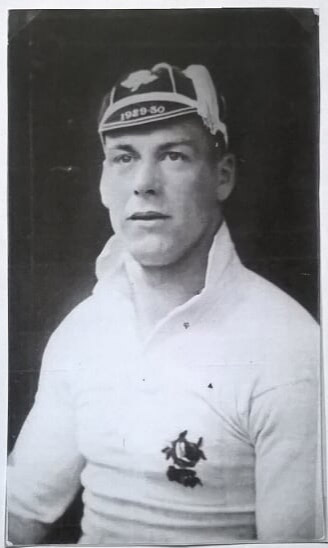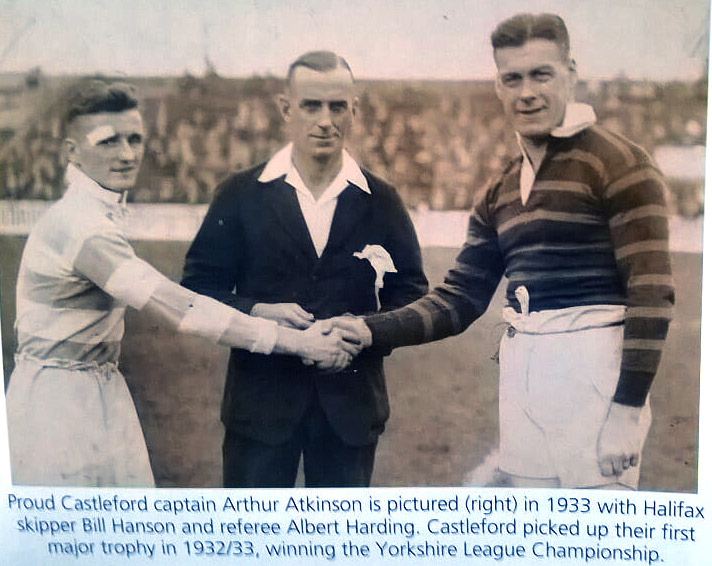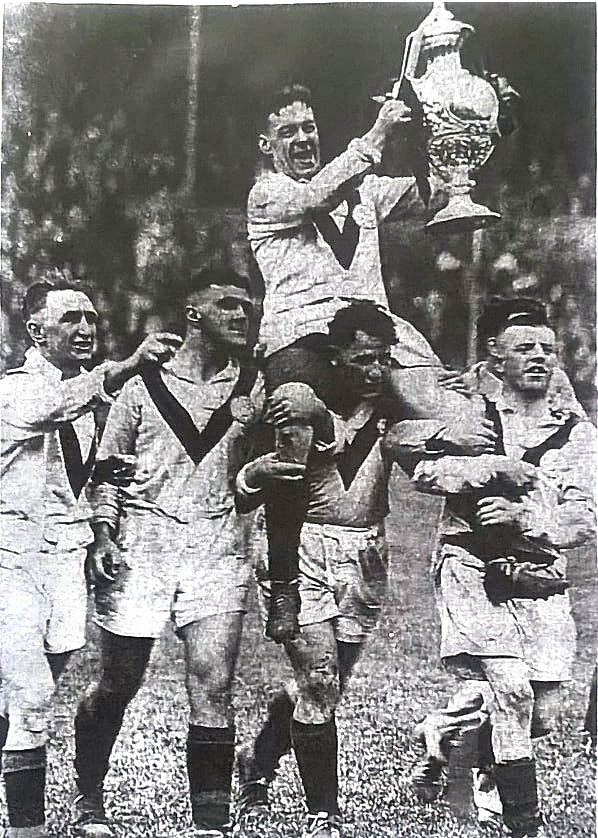Arthur Atkinson 562
Resource type: Articles
Arthur Atkinson

Arthur Atkinson was born on April 5,1906 at 12 Alfred Street, Castleford, just off Wheldon Road, where the now demolished Nestle's factory used to be.
The 1911 Census however shows the family residing in Radcliffe, Lancashire and Arthur, then aged 5, at school there.
Fortunately for Castleford fans however Arthur, at least, returned to Castleford.
Legend has it that Arthur was behind the posts one day at Castleford's old ground at Sandy Desert, Lock Lane, when he fielded the ball and with expert ease punted or drop-kicked it back into the field of play and that a certain Mr Walter Smith saw a potential star in the making.

Arthur signed for the club in 1926 as they made their introduction into the Rugby Football League and made his debut for the first team in their fifth match, away at Rochdale, on Saturday 11 September, 1926 when they lost 33-5.
Arthur quickly made his mark in the side and scored his first try against Halifax the following month although Cas were destined to finish bottom of the league in their first season.
Displaying strong qualities of leadership at an early age, he was appointed captain in the 1928-29 season, a role he retained until his retirement in 1942. His form that season alerted selectors to his abilities and he made his debut for Yorkshire, becoming the first Castleford player to gain such an honour, in the game against Glamorgan and Monmouth at Cardiff, going on to earn 14 caps for his county and became Castleford's first full international in that same season, eventually playing six times for England and ten times for Great Britain, including two tours to Australasia, for whom he scored five tries, and there were clear signs of what was to come as the team reached the semi final of the Challenge Cup, the first year that the final was to be played at Wembley.
The centre, known affectionately as Bruss, scored Castleford's first points against the touring Australians in 1929 and then appeared in three of the four tests, an extra game being arranged when a 0-0 draw in the Third Test resulted in a series draw. He had been a key figure in Great Britain avoiding a 2-0 series defeat, having been overlooked for the First Test which was lost 31-8, he enjoyed a superb debut, scoring a vital try to help Great Britain win the Second Test 9-3.

The Third Test was a 0-0 draw but ended controversially when the touch judge ruled that the Australian scrum half hit the corner flag in the act of scoring two minutes from time and the two nations then agreed to play a Fourth Test to settle the series.
Arthur played his part in a 3-0 win and completed an exhilarating year by being one of only three players retained for a pioneering exhibition match against Australia at the Municapalite de Paris, the first Rugby League contest in France and a game which, despite the Kangaroos 63-13 victory, helped pave the way for the birth of Rugby League across the Channel.
Also in 1929, at Knowsley Road, St. Helens, Arthur kicked a goal that may still remain the longest ever landed in Rugby League. His shot was measured at 75 yards and that statistic certainly stood as the record, in England at least, until 1940, when Swinton forward Martin Hodgson was credited with a kick of 77.75 yards in a match at Rochdale. However some historians have since maintained that Hodgson's kick was a mere 58 yards leaving Arthur as arguably the record holder.
He also reputedly dropped a goal from 66 yards in a cup tie at Belle Vue, Manchester the home of Broughton Rangers.
He was at the helm when Castleford won their first major trophy, the Yorkshire League Championship - a mere four years after the club's launch, in 1932-33 and made another kind of history in 1933 when being central to a major rule change. Castleford were 3-0 down to Swinton when Arthur broke clear, giving every appearance of being a certain scorer, only for a Swinton player who had been receiving treatment for an injury, to race in from the touchline and bring Arthur down.

Amid pandemonium the referee, unsure of his ground, had no alternative than to rule the tackle valid, In the cold light of day the Rugby Football League concluded that such acts were against the spirit of the game, and that in future all injured players should wait for permission to be granted before being allowed to return to the field of play. The result, however, was allowed to stand.
Immortality, as far as Castleford fans anyway, came in 1935, only nine years after the club were admitted to the league, when Arthur captained the first Castleford team to win the Challenge Cup at Wembley.
The first round was straightforward enough, a 33-4 home win against amateurs Astley and Tyldesley Collieries. The second round draw sent Cas over to Merseyside to play Liverpool Stanley. Again no try was conceded with an 8-2 success. It was in the quarter final where a record crowd, which still stands today, was set. An official attendance at Wheldon Road of 25,449 crammed into the compact ground to witness Cas take on cup holders Hunslet and to see Cas prevail 10-3 to reach their second Challenge Cup semi-final in their short history, having lost their previous one six years earlier to Dewsbury 9-3 and three Yorkshire Cup semi-finals in 1928, 1932 and 1934.
Barrow were the opposition in the semi-final at Station Road, Swinton. Good defence was on show and once Cas got in front Barrow found it hard to break them down. Eventually Cas ran out winners 11-5, scoring three tries to one and Arthur was carried off the field by his jubilant teammates. Wembley had been reached and in George V's Silver Anniversary Year.
Unbelievably Arthur's big match experience let him down early on in the final against firm favourites Huddersfield, He missed two try scoring opportunities by spilling the ball and hit an upright with a shot at goal and he must have felt that his errors could prove costly as Huddersfield's Welsh centre Idris Towill sold him a dummy to scamper over for an unconverted try but Cas hit back with Arthur taking over the goal-kicking duties from fullback George Lewis to kick a penalty goal and a try scored in the left corner by winger Tommy Askin saw Cas lead at half time by 5-3.

Scrum half Leslie Adams, playing against his former club, nosed Cas further ahead five minutes into the second half and winger Bernard Cunniffe crossed shortly afterwards to make it 11-3.
However Huddersfield never gave up and Arthur made perhaps the most important tackle of the match when he denied second row Henry Tiffany with a trademark diving stop. A penalty from Castleford born Herbert Sherwood eight minutes from time and an opportunist touchdown by Huddersfield captain Alex Fiddes came too late to prevent Cas and Arthur from lifting the Challenge Cup for the first time.
As previously stated Arthur was selected to represent Great Britain on two tours to Australasia, in 1932 and 1936, appearing in all six tests in 1932, three each against Australia and New Zealand, sharing in the Ashes success. He scored a try in the First Test at Sydney Cricket Ground in front of a crowd of 70,204 as the Lions won 8-6 and had impressive games in the subsequent Australian tests, particularly defensively in the Second Test known as the notorious ''Battle of Brisbane''. He bagged two tries in each of the opening two Tests in New Zealand, contributing tangibly to the 24-9 and 25-14 victories, and was again in the centre in the 20-18 Final Test win. The three-quarter line-up of Stanley Smith, Stan Brogden, Arthur and Alf Ellaby were universally acclaimed as equal to any the game has ever known.
He was made captain for the First Test against Australia in 1936, following Wigan's Jim Sullivan withdrawal from the Tour because of his wife's illness and the unavailability of Leeds fullback Jim Brough. Unfortunately Great Britain lost 21-8 and Arthur wasn't selected for another Test on the trip.
A report of the Second Test at Headingley in 1934 stated ''A brilliant tackle by Atkinson, who seemed to drop from the clouds when England's defence had been beaten by that wonderful Australian half-back Hey prevented a reverse result''.
After the 1936 Tour Arthur's international career was over but he remained a key figure at Wheldon Road, playing for the side until 1942.
He helped the side reach the 1939 Championship final at Maine Road, Manchester but did not play in the final.
He made 431 appearances for Castleford, scoring 157 tries and kicking 230 goals, including 1 drop-goal and scored 170 tries and 241 goals for 992 points in his career.
From 1932 to 1937 he was licensee of the Keel Inn on Bridge Street and during the 2nd World War he was a P.T. Instructor in the RAF. After the War and up to his untimely death in 1963 aged 57 he managed cinemas at Fitzwilliam and the New Star, Castleford. He was champion showman-manager in the entire circuit of 100 cinemas at one stage and his work for his children's matinee clubs earned him much recognition.
He was a life member of Castleford R.L.F.C and gave his name to the local Amateur Rugby League and the Supporters Club.
The Pontefract and Castleford Express wrote ''Crowds lined the pavements three deep around the Church Street area at his funeral at the Parish Church which was filled to the doors.''

Arthur's coffin was carried by six members of the 1935 Cup winning team and the Rector said Arthur Atkinson had made the greatest Castleford contribution to sport. Attaining a high position was to be honoured but the real question was what happened afterwards. Sometimes it was possible to go up in the world and down in the basic humanities but that was not so in Mr Atkinson's case as was illustrated by a remark made to him by an old woman.
Referring to Rugby football she had said that Arthur Atkinson had ''carried Castleford on his back many times but his head never got too big for his shoulders''.
From Warrington, Mr R F Anderton, who was joint manager writes that he will never forget Arthur Atkinson's performance in the 1936 tour of Australia and New Zealand. ''He was par excellence and no-one did more than he to win the Ashes. One of the best centres I have seen in 44 years as a Rugby League official.â€
The Mayor of Castleford, Alderman H Astbury paid tribute to Arthur as ''a grand citizen.'' Arthur Atkinson was a Castlefordian in every sense of the word. Arthur always felt that Castleford men were the best men for the Castleford team. When you are Castleford born you feel you are playing for the honour of the town. And he always put Castleford first. He had many chances to leave but he never would because he was a real Castlefordian''.
An ''Arthur Atkinson Memorial Fund'' was opened shortly after Arthur's death to raise monies to erect a memorial gate at the ground on Wheldon Road to commemorate the life and career of Castleford's first legend. The gate was duly erected and remains at the entrance to the ground to this day.
Acknowledgements
Pontefract & Castleford Express
Defining Moments for Castleford Tigers by Dr John Davis
20 Legends Castleford Rugby League by Phil Hodgson
The Staff of Castleford Library
Researched and written by Steve Poole



